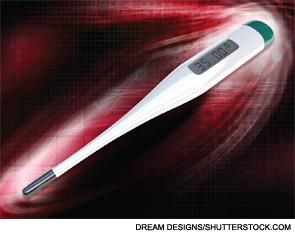
Rheumatologists are careful historians. They listen attentively to their patients, scouring their histories for clues that might lead to the correct diagnosis. They are always on the hunt for tangible evidence of an inflammatory process, because many of the diseases they treat are characterized by a litany of subjective complaints and a paucity of physical findings. Among the most worrisome words they may hear in the patient’s history or observe firsthand in their exam is the f word. No, not that one! I am referring to fever.
The presence of fever sounds an alarm, alerting caregivers to the possibility of infection and its dire consequences if the source and site are not quickly identified and treated appropriately. However, to rheumatologists, fever does not always connote infection. Clinical experience and recent research evidence have identified fever as a danger signal, apprising our brain and our immune system to excessive cytokine activation, whether due to infection or molecular mutations in the innate immune system.
Although fever is triggered by the stimulation of the thermoregulatory neurons nestled in the housekeeping hub at the base of our brains, better known as the hypothalamus, the cytokines that are critical for raising core temperature were only recently elucidated. Our colleague, Charles Dinarello, MD, professor of medicine at the University of Colorado in Denver, was the first investigator to observe that leukocyte pyrogen, a fever-inducing protein derived from white blood cells, alerted the hypothalamus to the danger lurking somewhere in the periphery.1
Around the time of this seminal observation, I was a medical resident involved in the care of a patient whose febrile illness highlighted the perils of failing to promptly identify a fever’s inflammatory origins. Monique was a 22-year-old student who celebrated her graduation from college by taking an extended backpacking trip through Central America. She hiked for miles through muddy rain forests and trekked along many treacherous mountain trails. When she finally returned to Montreal sometime in the dead of winter (which, in Montreal, can be just about any month except July!), she developed a fever. At first, she ignored the prickly warm sensation coursing through her body, assuming it would soon pass. But after several days of spiking temperatures to 105°F, she found herself drenched in sweat, lying in a hospital bed.
Given her recent travel to Central America, the medical team focused on a laundry list of potential infectious possibilities. These included tropical diseases rarely seen north of the 49th parallel: Chagas disease, dengue fever, yellow fever, typhoid fever, malaria and mycobacterial infection. Myriad tissue and fluid cultures failed to provide any solid clues.


